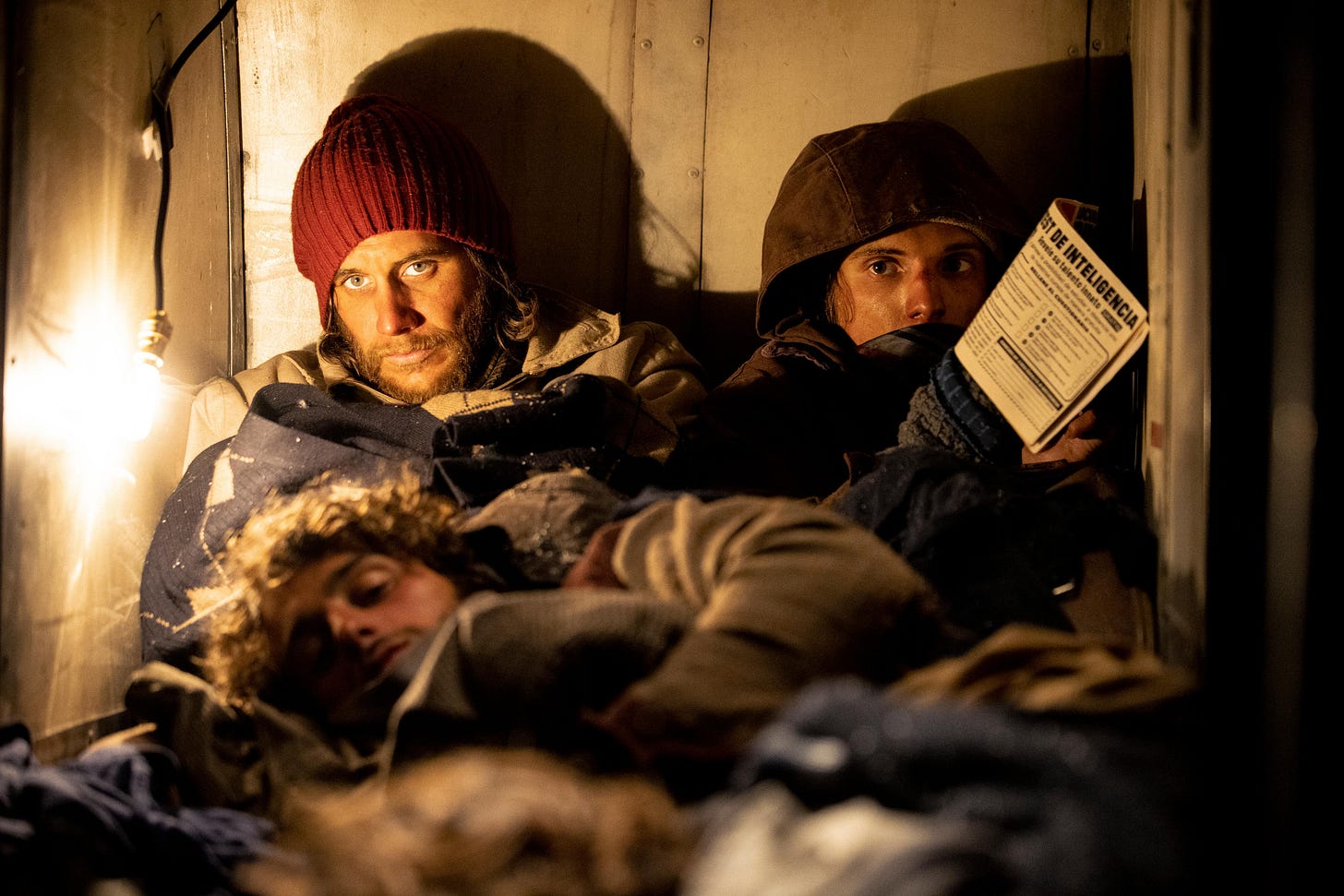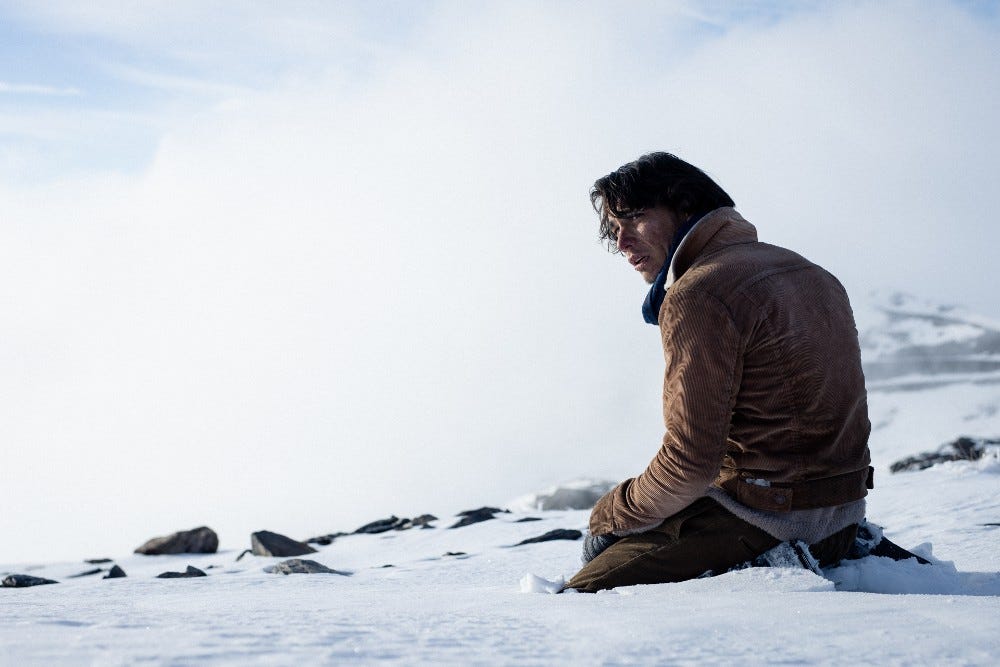Review - Society of the Snow
The Uruguayan plane crash of 1972 told again by Uruguayan actors, with a ton of spectacle and beauty but simplistic in its messaging and lacking in character.
I did not originally plan to write this review, but seeing the sensation it has been in popular culture and the amount of views it has gotten in Venezuela and worldwide, I had to take the chance to review the newest film by J.A. Bayona: Society of the Snow or La sociedad de la nieve in Spanish.
The film is based on true events and I do spoil some parts of it, so be warned if you want to watch it first. In general, though I have my reservations, it is worth the watch.
Also, next Tuesday the Oscar nominations will be announced, so I will publish another review on Monday (as always) and a breakdown of the nominations on Wednesday.
Overlong Spectacle: J.A. Bayona’s Society of the Snow
Production from Spain and the United States. Released on 2023.
J.A. Bayona has had quite the journey as a filmmaker. Focused on thrills and overall spectacle, particularly demonstrated in his 2012 film The Impossible, he was a perfect fit for the Hollywood machine to make more action films. And he did: he made an obscure fantasy film in 2016 for Universal and directed one of the Jurassic World films in 2018 to mixed results to say the least. While The Impossible has a ton of value in its setpieces, its ultimately simple story and message left me without much to chew on. Sure, Naomi Watts delivered a great -though not her best- performance, and Tom Holland started to become a more prominent figure, but after that and the visual effects, the film is just about finding each other without giving anything to comment on psychologically, socially, institutionally or artistically. While the same cannot be completely said about Bayona’s more recent effort Society of the Snow, as it does contain some semblance of a theme, its emphasis on spectacle, thrills, dread and twists gives the film less of a lasting impact as it should.
Society of the Snow tracks the plane crash of 1972 in the Andes mountains and the people in the plane who try to survive by all means necessary. Survival and the value of life is a central theme and Bayona puts some set-pieces to good use to connect with that central idea, but the film drags after the first half hour and though it does not exactly lose its idea, it's blurred into the background as it becomes a more conventional survival and rescue story.
The film begins in Uruguay as the rugby team prepares to go on the trip to Chile. The viewer gets to see some interesting background information, such as the student and labor protests occurring against the government, but the participants of the rugby team seem removed from it, maybe because of their privilege although it is never addressed again in the film. Instead, Bayona injects every scene with a sense of dramatic irony present in The Impossible. Every viewer knows what is about to happen, so Bayona heightens the sense of wonder and innocence of each character to later contrast with the life-changing experience they have later on. The crash sequence itself is a marvel: from breaking of parts, every injury, crush, scream, it is all deeply felt and more importantly heard. The sound design is one of this film’s big winners especially here.
After the crash the story truly begins as the survivors look for ways to communicate with the outside world while rationing their food supply to last as long as they can. Quickly through the film though, the survivors begin having an interesting debate. As their food supply is completely depleted and they realize that the authorities are not going to find them, they start discussing whether or not to eat the corpses of those who died in the crash and its aftermath. Some are understandably appalled by the idea and feel that consent should be given and that they are opening themselves to legal liabilities by manipulating corpses. And overall, it doesn't feel as good to be consuming a person you loved or at least knew personally, no matter how that relationship manifested itself. On the other hand, other survivors argue that their right for survival should outweigh the need to maintain corpses, even if it seems disagreeable to say the least. Eventually, every survivor eats parts of the corpses to survive, and the theme of community and helping each other out in life and in death is beautifully shown here, although it becomes more of an afterthought later on.
The philosophical and moral discussion around the need to eat should’ve been mined for more truths but sadly it got limited to a single discussion that felt surface-level. The other important moment that pays-off the theming surrounding the survival method is a speech given by the narrator of the film as his body gives into an infection. The will to live and keep on going is strong, but even stronger is the will to help each other out to make sure that the rest survive. So the purpose of life is not necessarily to keep on going on, but to ensure a sense of camaraderie perseveres, that a community thrives, that the goodness in people sees through it all. Even in another scene where a man describes the struggle to get himself out of a bind to help his wife, it shows that individual survival and community can never be directly opposed, both are directly linked to each other.
With that being said, I would’ve liked more of the film to show this theme, because it is just force-fed to the viewer through a couple of speeches two thirds through the film. Its imagery of the hallowed corpses would’ve been interesting to contrast and ultimately collide with these themes, and treated with enough sensitivity it could avoid being too disgusting, violent or gratuitous. To keep things accessible to the widest audience possible, I understand why Bayona did not want to take that stylistic risk, but for me it does come at the expense of quality.
My biggest gripe with the film is its choice of form, as the narrator left me scratching my head in confusion. As the film begins an actor begins narrating the story in voiceover, and as the story progressed, it became very difficult to identify who he was. Honestly, most characters lacked any traits that made them different from each other, so I never knew who I was supposed to stay with or who had which names. It was only at the end where many were in different spots that I started to understand who was who. But this is the problem, by not being able to set them apart, the intended effect of having the narrator give into his infection left me cold (no pun intended). As the viewer failed to build a relationship with him, it felt more like a tactic rather than a genuine statement.
Despite my gripes with it, Society of the Snow is a good film to watch and pass the time, and is definitely Bayona’s best film to date. His focus on spectacle often prevents him from going further with his story, but overall the messaging -though limited- makes the viewing experience affecting and worth it. For his next film, let’s hope Bayona becomes more skilled conveying meaning through visuals and building more individuality in his characters. The plane crash was a disaster, and though we spent almost two and a half hours with the survivors, we saw breathtaking sights but barely got to know the people that inhabited them.







